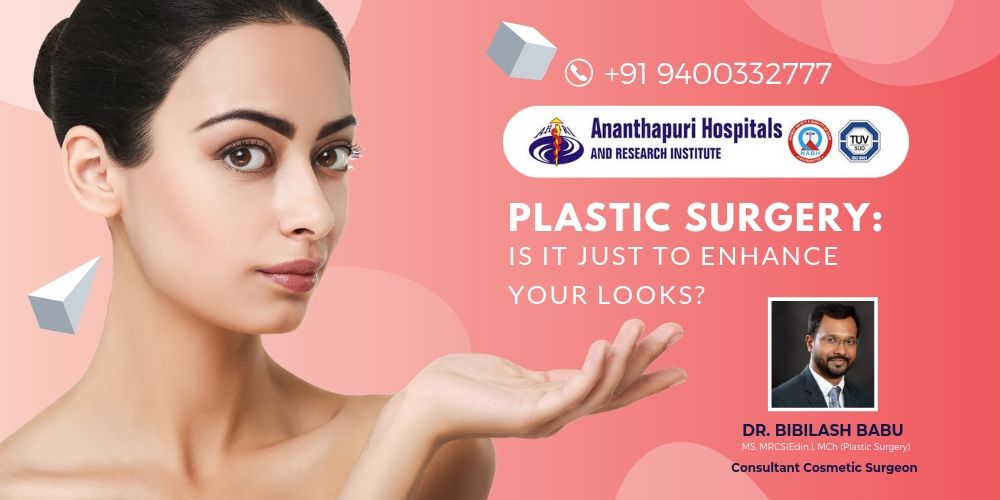- 08/July/2019

Plastic Surgery: Is It Just To Enhance Your Looks? - Ananthapuri Hospitals
What comes to your mind when you hear the word “Plastic Surgery”? Let’s be honest - images of certain celebrities? Words like ‘fake’ or unnatural’? It’s time to change your mind.
KEEP READING!
Many of you mistake plastic surgery for some kind of surgery that involves the use of plastic or other man-made material. You may also think that it is done only to improve the looks of an individual. Since plastic surgery is used interchangeably with cosmetic surgery, people often forget the other type of plastic surgery called ‘Reconstructive surgery’. Plastic surgery can be done not just for enhancing looks, but also to restore the appearance and functioning for someone who has a gross deformity or physical impairment - like in reconstructive surgery. In fact, the term ‘plastic surgery’ comes from the Greek word "plastikos" which means to mould or to shape.
Plastic surgery can broadly be classified into two groups:
- Cosmetic surgery
It is a type of plastic surgery that includes reshaping a healthy tissue or organ. It is done to improve the outward appearance of an individual who may not have a gross deformity or physical impairment.
- Reconstructive surgery
Reconstructive surgery is a type of plastic surgery that includes not only restoring the appearance but also improving body function. It is done to an individual who is diseased, injured or has a birth defect, to minimise discomfort and restore their day-to-day functions.
Let us look at some reconstructive surgeries to make you understand more about what they can do! Our guess is that you probably didn’t know they came under plastic surgery!
Trauma Surgery
Lacerations are cuts that happen in the skin or flesh. If they are small, it can be healed by using ointment, bandages or sutures. But if the laceration is severe, it may need reconstructive surgery to repair it. It can repair injuries that range from severed tendons and nerves to damaged muscle and bones.
Hand surgery
Hand surgeries are one of the most common reconstructive surgeries that results in improved hand function that is compromised by trauma or degeneration. This surgery is done to repair tendons or nerves, fractures and to reattach missing fingers. They are also used to treat joint problems such as osteoarthritis and rheumatoid arthritis, and correct birth defects such as webbed fingers, toes, and so on.
Craniofacial surgery
Craniofacial is related to the bones of the skull and face. Craniofacial surgery is a type of reconstructive surgery that repairs deformities or injuries that happen due to trauma or cancer. These injuries or deformities can affect the head, face, jaw and neck to such an extent that basic functions such as breathing or swallowing may be affected. In such cases, craniofacial reconstructive surgery is used to restore the functionalities.
Surgery for Congenital Anomalies
Malnutrition, alcohol consumption, drug use and infections during the pregnancy causes congenital anomalies. It can also happen due to genetic mutations. Some congenital anomalies require reconstructive surgery to improve the appearance and to repair the day-to-day functionality. This type of reconstructive surgery can repair the following defects:
- Cleft lip
- Cleft palate
- Birthmarks
- Head and face abnormalities
- Misshapen ears
Breast Reconstruction Surgery
For women who have undergone a partial or complete mastectomy, breast reconstruction is an essential part of their treatment and recovery process. Breast reconstruction is done to restore the size, shape and the look of the breast close to normal. In this process, the skin expands to a new breast shape and implants are placed inside. In case of insufficient tissue, tissues from the lower abdomen, back or buttocks are used to rebuild breasts. This type of surgery is called tissue flap surgery.
Reattachment Surgeries
Reattachment surgeries involve re-attaching appendages - fingers, toes, hands, feet and arms - back to the body. Any damaged tendons and nerves are treated while reattaching the severed body part. This surgery needs to be performed within four to six hours from when the body part is amputated. The earlier it is done, the better chance of success.
Scar Revision
Scars can form from an accident or as a part of recovery from surgery. It is a way our body protects itself when the skin is injured. Only scars that are severe enough - thick, uncomfortable, and reduces mobility - qualify for scar revision. Scar revision may include removal of excess tissue, repositioning and minimising the visibility of the scar. The result is a smoother scarred area, restored muscle and restored tendon functionality.
Reconstructive surgery for Burn Care
Third-degree burns cause severe damage to the skin and only a reconstructive surgery can help heal it. Reconstructive surgery is done for burns to reduce disfigurement and minimise disabilities caused by skin grafts and scarring. These surgeries include cleansing the wound and replacing the injured skin with skin from another body part.
Reconstructive surgery for Tumour Removal
Tumour removal is a common surgery that includes removal of both benign (noncancerous) and malignant (cancerous) tumours. Large tumours and skin cancers need procedures that result in bone loss or leave behind a significant amount of tissue. With the help of reconstructive surgeries such as grafting or tissue flaps, the day-to-day functions can be restored through minimal scarring.
----------------------------------
The Plastic and reconstructive surgery wing of Ananthapuri Hospitals and Research Institute has a highly qualified and competent team of surgeons who can perform reconstructive surgeries to improve the quality of patients’ life.
To book an appointment, call us at +91 9400332777 or visit our hospital at Chacka, NH Bypass, Thiruvananthapuram.

